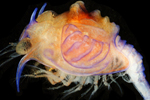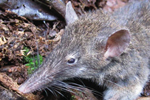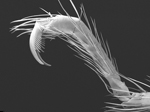
The now famous poodle moth, species unknown. Photo by: Arthur Anker.
A white moth from Venezuela that bears a striking resemblance to a poodle has become an Internet sensation, after cryptozoologist Karl Shuker posted about the bizarre-looking species on his blog. Photographed in 2009 in Venezulea’s Canaima National Park in the Gran Sabana region by zoologist Arthur Anker from Kyrgyzstan, the white, cuddly-looking moth with massive black eyes has yet to be identified and could be a species still unknown to science.
“When I emailed [Arthur] to ask if he knew this moth’s species, he informed me that he did not, and he also revealed that no other zoologist he’d spoken to knew either,” writes Shuker. “Indeed, no-one had even been able to name its genus!”
While Shuker and entomologists around the world are debating the species, they stress that mystery will not be solved until a specimen of the animal can be recovered.
Hopefully the photo will help spur some ambitious entomologists to trace Anker’s footsteps and attempt to rediscover the ‘poodle moth.’
For more photos from Arthur Anker’s trip in Venezuela.
Related articles
‘Monster larva’ turns into a shrimp

(08/28/2012) With blue devil-shaped horns and red armor, the monster larva, or Cerataspis monstrosa, kept scientists guessing for nearly 200 years; infrequently found in the bellies of marine predators, researchers could not imagine what this larva became as an adult. Now they do: the monster larva becomes a deep sea shrimp, known as Plesiopenaeus armatus, which bares little monstrous resemblance to its larval stage, according to DNA studies published in Ecology and Evolution.
‘Penis-headed’ fish discovered in Vietnam
(08/27/2012) A bizarre penis-headed fish has been discovered in Vietnam, according to a new paper published in the journal Zootaxa.
Bizarre new rodent discovered in Indonesia has only 2 teeth

(08/22/2012) The Indonesian island of Sulawesi is a workshop of bizarre evolutionary experiments. Think of the babirusa, pig-like species with tusks that puncture their snouts; or the maleo, a ground-bird that lays its eggs in geothermal heated sand; or the anoa, the world’s smallest wild cattle. Now the island, made up of four intersecting peninsulas, can add another bizarre creature to its menagerie of marvels: the Paucidentomys vermidax, a new species of rodent that is different from all others.

(08/20/2012) Paula Kahumbu, the Executive Director of WildlifeDirect and a 2011 National Geographic Emerging Explorer, is on a mission to reconnect young Africans with the natural world through storytelling. In a new initiative dubbed Africa’s Wildest Stories, Kahumbu and others are recording the wit and wisdom of African elders in Kenya as they share their love of nature and the way in which Africans, for millennia, have co-existed with their environment and its astounding wildlife.
Velociraptor spider discovered in Oregon cave (pictures)

(08/17/2012) Scouring the caves of Southwest Oregon, scientists have made the incredible discovery of a fearsome apex predator with massive, sickle claws. No, it’s not the Velociraptor from Jurassic Park: it’s a large spider that is so unique scientists were forced to create a new taxonomic family for it. This is the first new spider family to be discovered in North America in over 130 years. ‘This is something completely new,’ lead author of a paper on the species, Charles Griswold with the California Academy of Sciences, told SFGate. ‘It’s a historic event.’